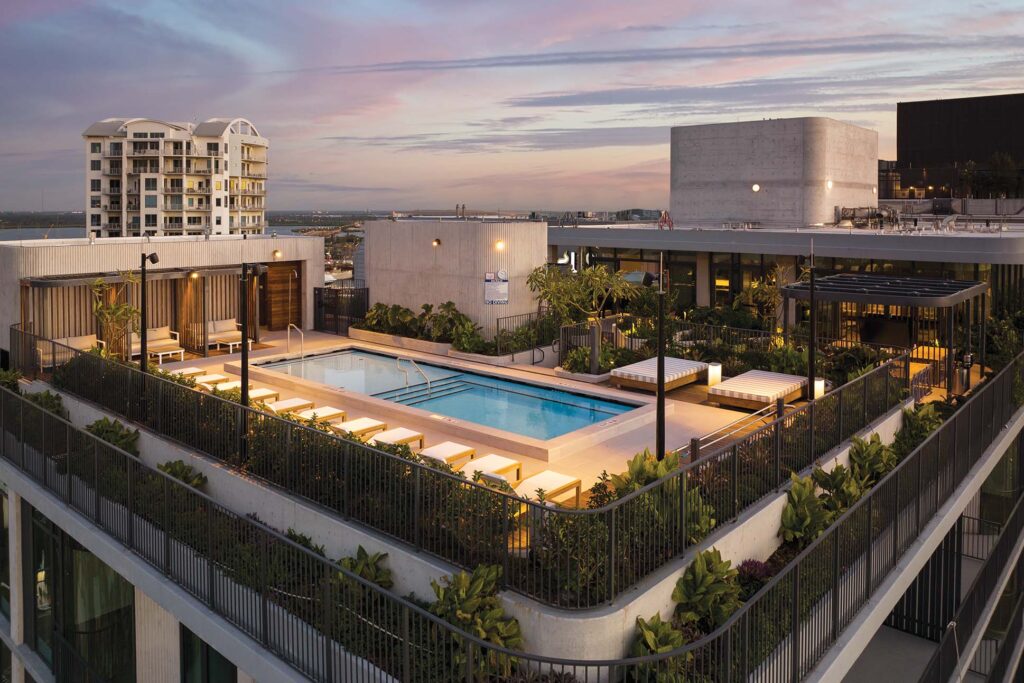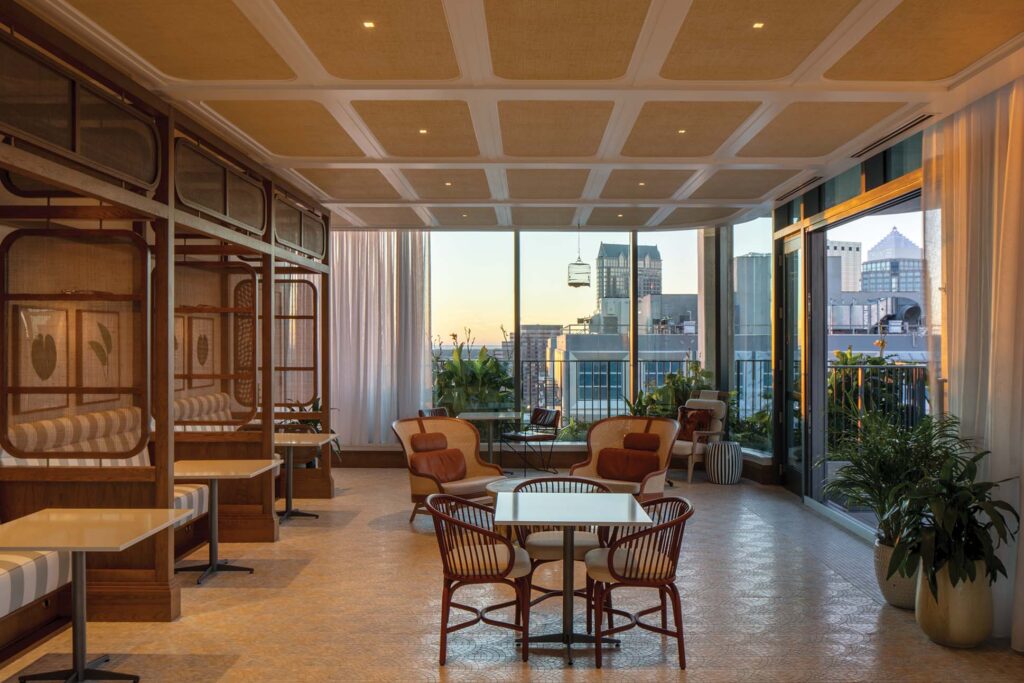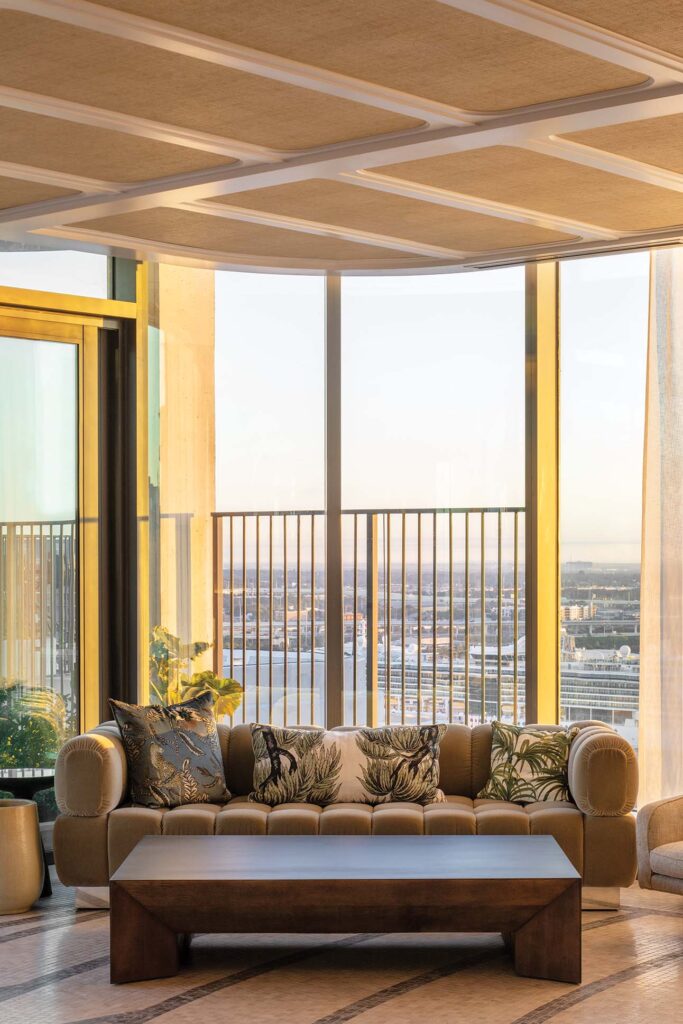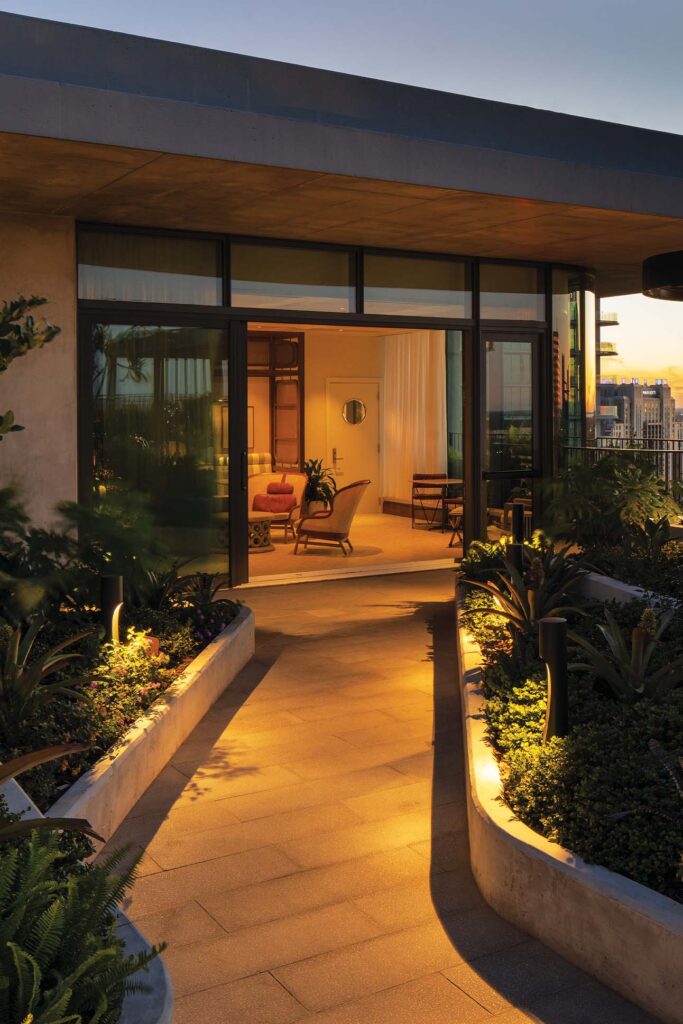By Nadja Sayej
Photos by Seamus Payne
Water Street Tampa features several striking new mixed use towers. Among them you’ll find The Tampa EDITION (the city’s first five star hotel), the beautiful residential building Heron (above a Publix GreenWise Market, serving fresh organic foods and house-made specialties), and Thousand & One, a 20-story biophilic office building drawing businesses to the new neighborhood, the world’s first-ever WELL pre-certified community.
What that means is Water Street Tampa meets the stringent wellness requirement outlined by the WELL Community Standard, which aims to impact individuals not just within the walls of their homes or workplace, but throughout the public spaces where they spend their days. In short, a WELL Community is designed to support the health and well-being across all aspects and areas of community life.
In fact, Water Street has been created from scratch “with design and policy strategies meant to improve wellbeing,” says Liza Berger, senior manager of marketing at Strategic Property Partners (SPP), who developed the neighborhood.

That forward-thinking directive was top of mind for COOKFOX Architects who designed Thousand & One along with its neighboring luxury residential tower, Cora.
Even to the untrained eye, something stands out about the building at 1011 East Cumberland Ave. Cora’s curved balconies and rounded edges make it feel windswept and organic, and its grassy rooftops and biophilic design add pops of fresh greenery that make it feel alive.
“We wanted to create a strong connection to nature,” says Zach Craun, an associate partner at COOKFOX. Much like the newly-erected Water Street Tampa neighborhood it proudly stands in, the health and well-being of its residents was always a priority.
Others: To Craun, architecture embodies a dialogue between past, present, and future through a thoughtful appreciation of place. Tampa saw its population skyrocket in the early 1900s after Henry B. Plant’s railroad made connections more feasible for Vincente Martinez Ybor and the cigar industry he brought along with him from Key West. And with Ybor came the city’s economy which soon helped it to become Florida’s largest city by the early 20th century.

That past movement and energy is what Cora designers drew on when they thought big for this project.
“We believe that the materiality and expression of Cora provides a tangible point of contact with the history and culture of the site,” says Craun. “These aspects of our practice uphold the circular commitment of architecture, preserving the past so it may guide the future.”
Whatsmore, the design team at COOKFOX used cast-in-place concrete as a material to nod to the city’s industrial past, and the nearby shipping port. But the main design highlight of the building are its curved corners, which offer a modern elegance not seen in the city before.
“Cora’s curvilinear geometry is rooted in both its ecological and architectural context,” explains Craun. “There are no sharp corners in nature; Tampa’s residents are familiar with this due to their proximity to beautiful beaches, water, and sunsets. Curved corners create a softer impression on the skyline, seamlessly blending in with the breezy scenery.”



Cora’s interior is equally impressive, as it features a spacious lobby, an array of high-end amenities, and a beautiful view of the Tampa Bay skyline. Its light-filled lobby features a luxurious lounge area, a modern media room, and a full-service restaurant. The COOKFOX team also implemented small decorative homages to honor the architectural history of Art Deco and Streamline Moderne styles in Florida design as well.
“Upper floor balconies and heavily-vegetated roof decks provide prospect and refuge, a core idea of biophilia,” says Craun.
There’s that word again.
Residents of Cora are part of this larger neighborhood that has been designed with their health in mind.
Liza Berger
Biophilia. For those unaware, it’s the innate human instinct to connect with nature and other living things. Biophilic design attempts to bring the outdoors in, so to speak, by introducing said nature in a space and maximizing natural light, among other things. Such design has been shown in studies to elevate mood, boost immunity, and reduce mental fatigue. “Bringing in aspects of biophilic design can also help reduce anxiety, improve cognitive performance and make for a better night’s sleep,” says Cigna Global of one study written about on their site under the headline, “What is biophilia and why do we need it?”
The movement, which has become more popular of late, was an essential part of COOKFOX’s design approach. “Channeling an innate human affinity for organic materials, biomimetic patterns, and ample daylight, we have a vision of architecture that connects building occupants with nature,” Craun says.
As such, residents of Cora enter through a quiet landscaped courtyard into a calming, bright lobby complete with natural materials and textures. Balconies on each floor support the Floridian culture of indoor-outdoor living and connect residents to the seasons. In addition to the grassy green rooftop, inside each unit are deep-slabbed edges to shade interior spaces.

“Winding planted canopies, extending from Cora’s first floor over the sidewalks underneath, reinterpret historical street arcades found throughout the city,” says Craun. “These elements also serve a practical function; they reduce the heat island effect, provide shade for pedestrians, and filter light at the street level.”
Craun also notes some of the other highlights of Water Street Tampa’s urban vision, which includes a bustling public plaza, mixed-use offerings, walkability, and a vibrant retail community.
Such wellness-focused design can be found throughout Water Street Tampa with its drinking fountains, bottle-refilling stations, ample bike lanes, public art installations, and regular community wellness events like pilates in Raybon Plaza or yoga on the Sparkman Wharf recreational lawn.
“Residents of Cora are part of this larger neighborhood that has been designed with their health in mind,” says Berger.
And here, it’s health they’ll find. Water Street Tampa has room to run and roam, to work and play, and to find quiet places to stretch, breathe, and be present with the surrounding energy.
Cora is one of the many standouts of Water Street Tampa, a neighborhood that’s not lacking for them. Its unique design stands as a testament to Tampa’s continued commitment to stunning architectural works, and is the perfect embodiment of the neighborhood’s modern, vibrant spirit.


